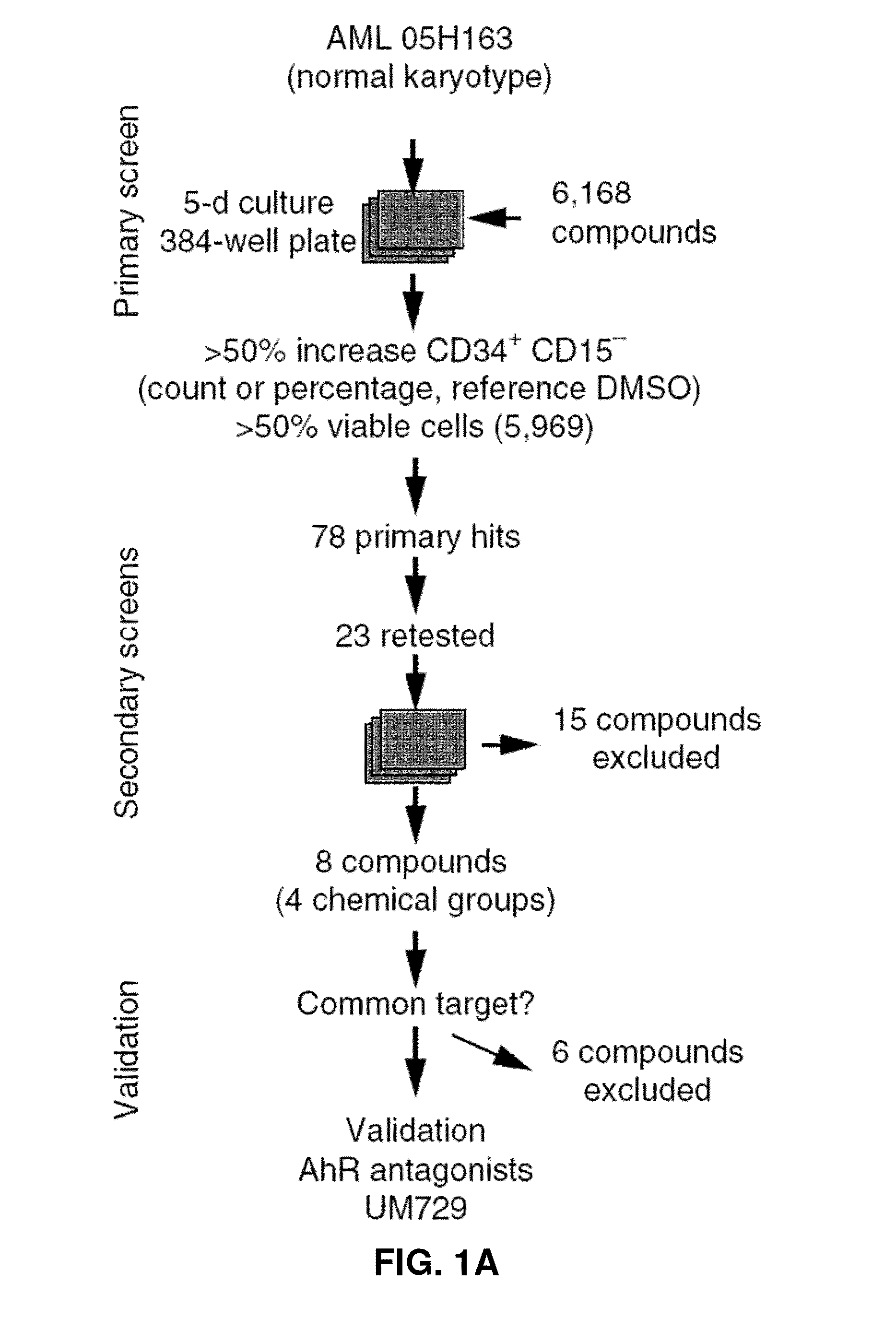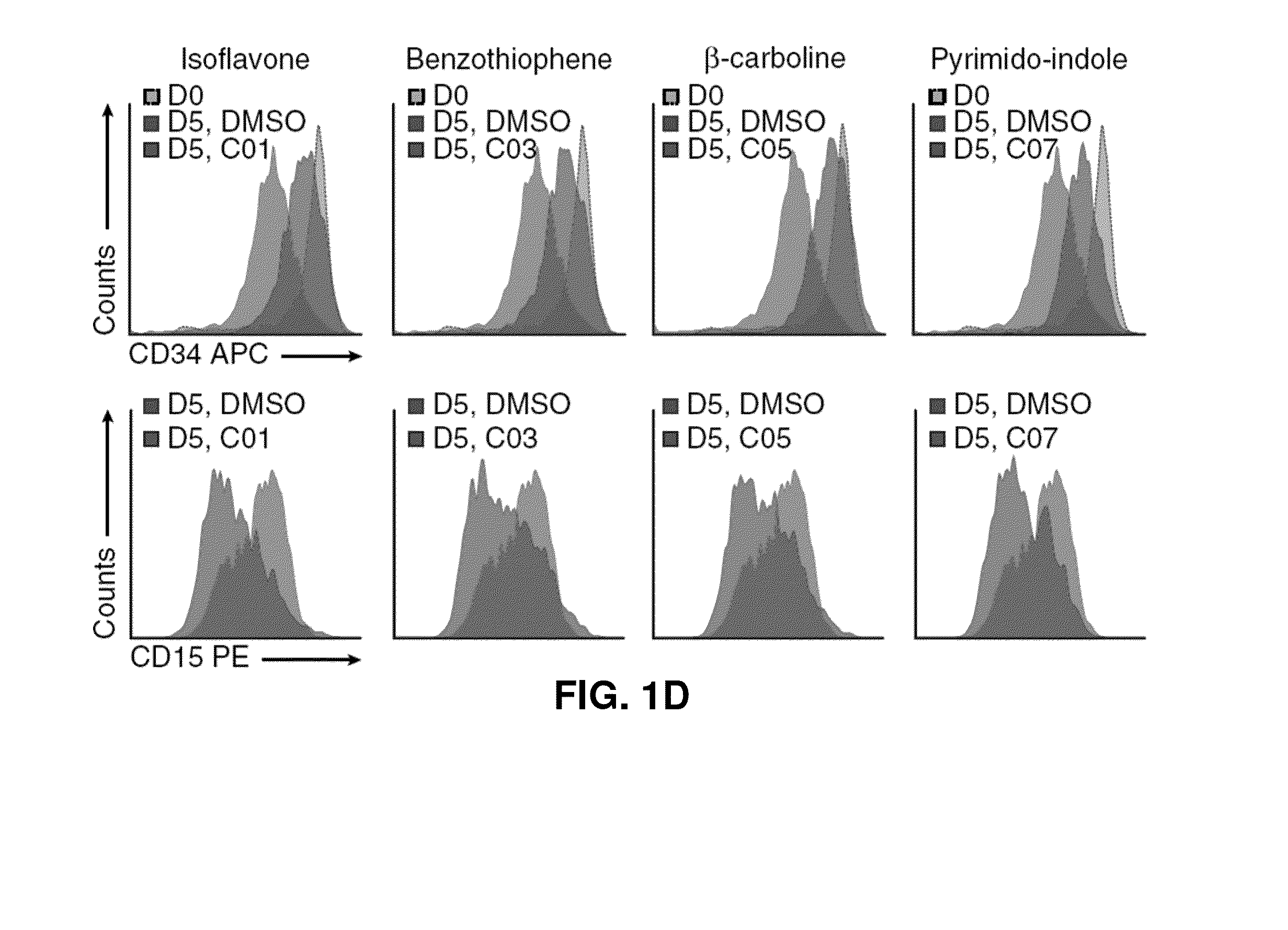Methods to modulate acute myeloid leukemia stem/progenitor cell expansion and/or differentiation
a technology of stem/progenitor cell and acute myeloid leukemia, applied in the field of cancer, can solve the problems of affecting the development of lic targeted therapies, putting doubt on the interpretation of results, etc., and achieve the effect of promoting expansion or maintenance, inhibiting or preventing the differentiation of acute myeloid leukemia
- Summary
- Abstract
- Description
- Claims
- Application Information
AI Technical Summary
Benefits of technology
Problems solved by technology
Method used
Image
Examples
example 1
Material and Methods
[0342]AML Specimens
[0343]All AML specimens used in this study are from adult AML patients and were analyzed and cryopreserved at Leukemia Cell Bank of Quebec at Maisonneuve-Rosement Hospital, Montreal. Detailed patient and specimen characteristics are provided in FIGS. 15A-15C.
[0344]Cell Culture
[0345]AML cells were thawed in 37° C. water bath and 1:10 diluted in prewarmed Iscove's modified Dulbecco's medium (IMDM) containing 20% FBS and DNase 100 μg / ml. Cells were cultured in IMDM supplemented with 15% BIT (bovine serum albumin, insulin, transferrin, Stem Cell Technologies #09500), SCF 100 ng / ml (Shenandoah #100-04), FLT3L 50 ng / ml (Shenandoah #100-21), II-3 20 ng / ml (Shenandoah #100-80), G-CSF 20 ng / ml (Shenandoah #100-72), 3-mercaptoethanol (10−4M), gentamicin (50 μg / ml) and ciprofloxacin (10 μg / ml). For high-throughput screening (HTS) the culture medium was prepared with 15% FBS instead of BIT. When compounds were added to the culture medium, final DMSO concen...
example 2
Small Molecules Inhibit AML Cell Differentiation Ex Vivo
[0364]To identify small molecules that expand primary human AML cells in vitro while maintaining their phenotypic, morphologic, and functional characteristics, ˜6,000 compounds were tested in a chemical screen comprised of commercially available compounds and small molecules proprietary to IRIC (FIG. 1A). Given the lack of definitive markers that prospectively identify leukemic stem and progenitor cells, the continuous loss of CD34 expression and the acquisition of lineage markers was monitored by flow cytometry as an indication of ongoing differentiation during in vitro culture (FIG. 1B). CD15 was chosen as a lineage marker; this was an important secondary marker to avoid bias for compounds that directly affect CD34 gene / protein expression. Surprisingly, primary hit compounds were highly enriched (34%) for Iso- / Flavonoids (Table 1). A subset of primary compounds was therefore selected for dose-response experiments, and eight c...
example 3
The AhR Pathway is Rapidly Activated in AML Cells Ex Vivo
[0365]Given the enrichment for AhR suppressors among hit compounds, it was assessed whether AhR suppression reflects the physiology of human AML cells in vivo and whether AhR activation was common to all AML specimens when exposed to in vitro conditions. RNA-Seq data of 50 AML specimens with normal karyotype (FIGS. 16A-16C) was examined and it was found that canonical AhR targets are not expressed, although the receptor itself is well expressed in nearly all samples analyzed (FIG. 2A). Upon 24 h in vitro culture, a marked upregulation of AhR target genes AHRR and CYP1A1 (53- and 180-fold, respectively) was observed in control conditions (DMSO). This upregulation was effectively antagonized by SR1 and could only be marginally further induced by the known AhR agonist 2, 3, 7, 8-Tetrachlorodibenzodioxin (TCDD) indicating that the pathway is near maximally activated by in vitro culture conditions (FIG. 2B). The upregulation of AhR...
PUM
| Property | Measurement | Unit |
|---|---|---|
| size | aaaaa | aaaaa |
| resistance | aaaaa | aaaaa |
| chemical structures | aaaaa | aaaaa |
Abstract
Description
Claims
Application Information
 Login to View More
Login to View More - R&D
- Intellectual Property
- Life Sciences
- Materials
- Tech Scout
- Unparalleled Data Quality
- Higher Quality Content
- 60% Fewer Hallucinations
Browse by: Latest US Patents, China's latest patents, Technical Efficacy Thesaurus, Application Domain, Technology Topic, Popular Technical Reports.
© 2025 PatSnap. All rights reserved.Legal|Privacy policy|Modern Slavery Act Transparency Statement|Sitemap|About US| Contact US: help@patsnap.com



